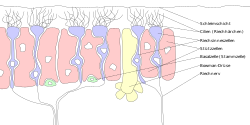Olfactory receptor neurons
| Olfactory receptor neuron | |
|---|---|

Labels in German. "Zellen" = "cell","riech" = "smell", "Riechnerv" = olfactory nerve, "cillien" = cilia.
|
|
| Details | |
| Location | olfactory epithelium in the nose |
| Morphology | Bipolar sensory receptor |
| Function | Detect traces of chemicals in inhaled air (sense of smell) |
| Neurotransmitter | Glutamate |
| Presynaptic connections | None |
| Postsynaptic connections | Olfactory bulb |
| Identifiers | |
| Code | TH H3.11.07.0.01003 |
| NeuroLex ID | Olfactory receptor neuron |
|
Anatomical terminology
[]
|
|
An olfactory receptor neuron (ORN), also called an olfactory sensory neuron (OSN), is a transduction cell within the olfactory system.
Humans have about 10 million olfactory receptor neurons. In vertebrates, ORNs are bipolar neurons with dendrites facing the external surface of the cribriform plate with axons that pass through the cribriform foramina with terminal end at olfactory bulbs. The ORNs are located in the olfactory epithelium in the nasal cavity. The cell bodies of the ORNs are distributed among all three of the layers of the olfactory epithelium.
Many tiny hair-like cilia protrude from the olfactory receptor cell's dendrite into the mucus covering the surface of the olfactory epithelium. The surface of these cilia is covered with olfactory receptors, a type of G protein-coupled receptor. Each olfactory receptor cell expresses only one type of olfactory receptor (OR), but many separate olfactory receptor cells express ORs which bind the same set of odors. The axons of olfactory receptor cells which express the same OR converge to form glomeruli in the olfactory bulb.
ORs, which are located on the membranes of the cilia have been classified as a complex type of ligand-gated metabotropic channels. There are approximately 1000 different genes that code for the ORs, making them the largest gene family. An odorant will dissolve into the mucus of the olfactory epithelium and then bind to an OR. ORs can bind to a variety of odor molecules, with varying affinities. The difference in affinities causes differences in activation patterns resulting in unique odorant profiles. The activated OR in turn activates the intracellular G-protein, GOLF (GNAL), adenylate cyclase and production of cyclic AMP (cAMP) opens ion channels in the cell membrane, resulting in an influx of sodium and calcium ions into the cell, and an efflux of chloride ions. This influx of positive ions and efflux of negative ions causes the neuron to depolarize, generating an action potential.
...
Wikipedia
